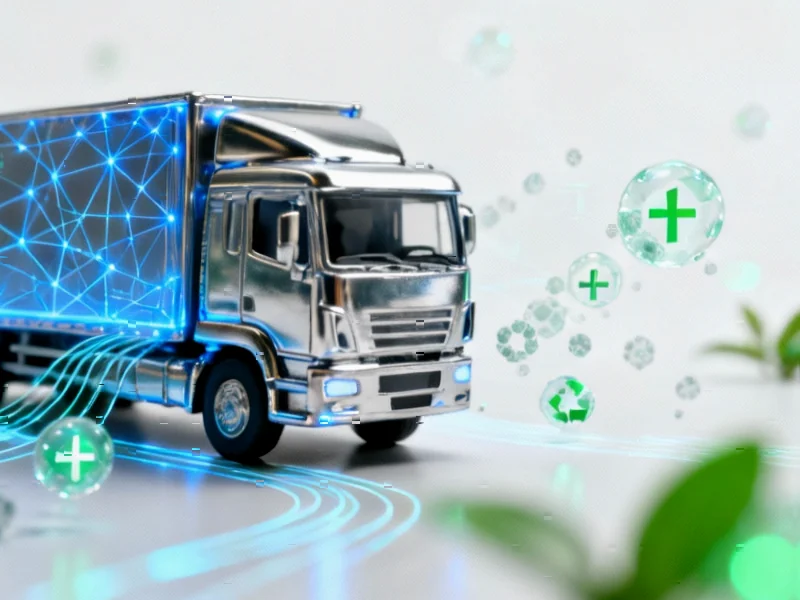The Digital-Logistics Nexus: A New Frontier in Carbon Efficiency
As global supply chains face increasing pressure to decarbonize, the intersection of digital transformation and logistics operations presents a compelling opportunity for environmental progress. Recent research examining China’s provincial data from 2012-2021 reveals sophisticated mechanisms through which the digital economy enhances carbon emission efficiency (CEE) in logistics—a sector historically characterized by high energy consumption and significant environmental impact.
Table of Contents
- The Digital-Logistics Nexus: A New Frontier in Carbon Efficiency
- Beyond Linear Relationships: Understanding the Nonlinear Dynamics
- Dual Pathways: How Digital Transformation Reshapes Logistics Operations
- Spatial Spillovers: The Regional Ripple Effects of Digital Logistics
- Regional Disparities: Context Matters in Digital Environmental Benefits
- Strategic Implications for Logistics Operators and Policymakers
- The Road Ahead: Digital Economy as Catalyst for Sustainable Logistics
Beyond Linear Relationships: Understanding the Nonlinear Dynamics
Contrary to simplistic assumptions about technology‘s environmental benefits, the study demonstrates a nonlinear relationship between digital economy development and logistics carbon efficiency. This complexity suggests that digital transformation follows a maturation curve where initial investments may yield modest returns until critical mass is achieved. The research employed sophisticated measurement approaches, using entropy method for digital economy assessment and super-SBM modeling for carbon efficiency evaluation, providing robust methodological grounding for these nuanced findings., as additional insights
The implications are significant for logistics operators planning digital transformation. Rather than expecting immediate carbon efficiency gains, companies should anticipate a progression where digital capabilities accumulate until reaching inflection points that trigger substantial environmental improvements.
Dual Pathways: How Digital Transformation Reshapes Logistics Operations
The research identifies two primary mediating channels through which digital economy influences carbon efficiency:
Industrial Structural Upgrading: Digital technologies enable fundamental restructuring of logistics operations, moving from fragmented, inefficient systems toward integrated, intelligent networks. This includes automation of warehouse operations, optimization of routing algorithms, and implementation of smart inventory management—all contributing to reduced energy intensity per unit of logistics output., according to expert analysis
Energy Structure Optimization: Beyond operational improvements, digitalization facilitates transition toward cleaner energy sources. Real-time energy monitoring, predictive maintenance of equipment, and integration of renewable energy sources into logistics infrastructure become more feasible through digital platforms and IoT applications., according to industry experts
Spatial Spillovers: The Regional Ripple Effects of Digital Logistics
One of the most intriguing findings concerns the spatial spillover effects observed across provincial boundaries. As regions develop their digital logistics capabilities, neighboring areas experience both competitive pressure and demonstration effects that influence their own carbon efficiency trajectories. This creates a dynamic where regional digital development becomes interconnected, with pioneering regions effectively pulling adjacent areas toward higher environmental standards.
The spatial Durbin model analysis revealed that these spillovers follow nonlinear patterns, suggesting that the transmission of digital environmental benefits operates through complex regional economic networks rather than simple geographic proximity.
Regional Disparities: Context Matters in Digital Environmental Benefits
Significant heterogeneity emerged across different regions, highlighting that the carbon efficiency benefits of digital transformation are not uniformly distributed. Factors such as existing infrastructure, economic development levels, and institutional capacity all mediate how effectively regions can translate digital investments into environmental gains.
This underscores the importance of context-specific digital strategies rather than one-size-fits-all approaches. Regions with advanced manufacturing bases and strong technology ecosystems demonstrated different digital-to-environmental conversion patterns compared to areas with more traditional economic structures.
Strategic Implications for Logistics Operators and Policymakers
The findings offer actionable insights for multiple stakeholders in the logistics ecosystem:
- For logistics companies: Digital transformation should be viewed as a comprehensive restructuring opportunity rather than merely implementing discrete technologies. The nonlinear nature of benefits suggests the importance of sustained investment and strategic patience.
- For policymakers: Regional coordination mechanisms can amplify positive spillover effects, creating digital-environmental synergies across geographic boundaries. Targeted support for lagging regions can help ensure more equitable distribution of environmental benefits.
- For technology providers: Understanding the mediating role of industrial structure and energy systems highlights opportunities to develop integrated solutions rather than standalone digital tools.
The Road Ahead: Digital Economy as Catalyst for Sustainable Logistics
As the logistics industry continues its digital transformation journey, this research provides a more sophisticated understanding of how technological advancement translates into environmental performance. The identification of nonlinear relationships, mediating mechanisms, and spatial dynamics offers a framework for more effective strategy development and policy intervention.
The challenge moving forward lies in leveraging these insights to accelerate the transition toward carbon-efficient logistics systems while managing the regional disparities that currently characterize this transformation. With digital technologies evolving rapidly and climate pressures intensifying, the intersection of these domains will only grow in importance for logistics operators worldwide.
Related Articles You May Find Interesting
- Wind Energy Storage Innovation Surges as Patent Filings for LDES Technologies Do
- Advanced Computational Screening Uncovers Potent Stigmasterol Analogs as Next-Ge
- Data Decontamination Breakthrough Transforms Drug Discovery Predictions
- Legacy Tech Debt: How Outdated Systems Amplified Economic Pain During Pandemic
- Einstein’s Scientific Stumbles: How His “Mistakes” Advanced Physics
This article aggregates information from publicly available sources. All trademarks and copyrights belong to their respective owners.
Note: Featured image is for illustrative purposes only and does not represent any specific product, service, or entity mentioned in this article.



